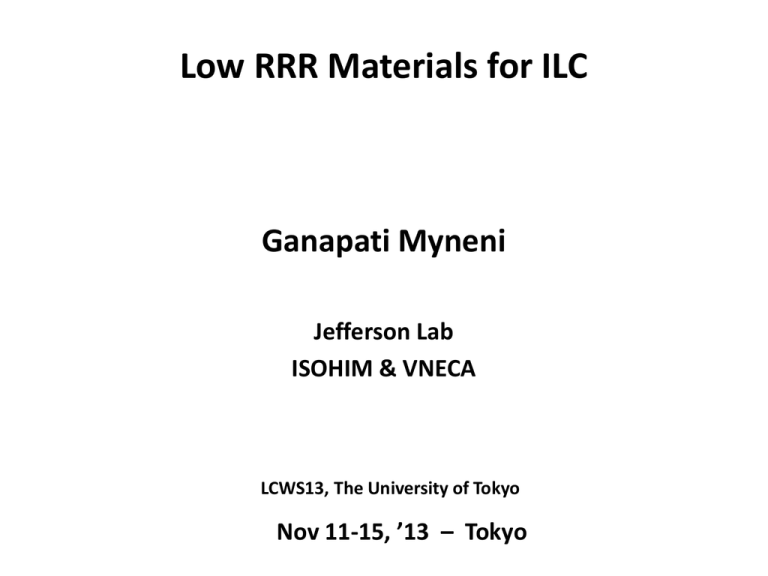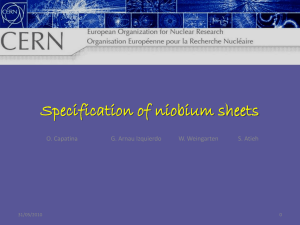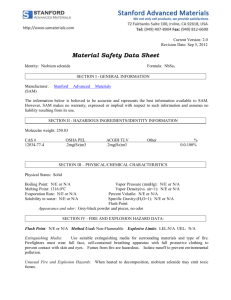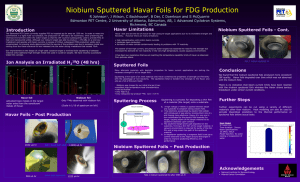Myneni_LCWS13
advertisement

Low RRR Materials for ILC Ganapati Myneni Jefferson Lab ISOHIM & VNECA LCWS13, The University of Tokyo Nov 11-15, ’13 – Tokyo Outline Early History Present Status Future Prospects Summary Historical Example of Ingot Niobium 1 Hpk~ 108 mT with BCP Stanford solid niobium cavity 1970 Historical Example of Ingot Niobium 2 Siemens solid niobium cavity 1973 Hpk~ 109 mT with BCP Hpk~ 130 mT with EP EP’d reactor grade fine grain niobium cavity set a record Hpk of 159 mT Ingot niobium DC magnetization S.B. Roy/RRCAT 10/6/2011 Highlights of Early SRF Technology • Cavities were mostly made from ingot niobium – Process and procedures were similar and as varied as today • Reactor grade Niobium material in ingot, bar, plate sheet and tube form was available • Achievable gradient limited by multipacting and/or field emission • Residual surface resistance (~ 1nΩ) was not well understood – Still the case • At highest frequencies (Electropolished fine grain, X-band) Hpk ~ 159 mT Q0 ~5x109 • (BCP’d ingot Nb, 1970’s) Hpk ~ 108 mT & Q0 ~1×1011 @ 1.2 K CW • For comparison (CEBAF upgrade spec.) Hpk ~ 76 mT Q0 ~ 7×109 @ 2 K CW (2008) Extrinsic and intrinsic contamination of Nb determines the performance of the cavities Extrinsic • Surface contamination – Molecular and particulate Intrinsic • Niobium is a prolific hydrogen absorber in the absence of the natural surface oxide – Hydride formation – Dislocations Niobium Specifications – Past & Present @JLab • Polycrystalline Niobium with ASTM #5 Grain Size or finer ~ 50 micro meters & 90% recrystallized • Percentage of elongation > 25 • Yield Strength > 10.7 KSI (~75 MPa) (7 KSI for SNS) • RRR > 250 • Tantalum < 1000 wt ppm Note: Recrystallization and high yield strength (YS) are mutually exclusive, the “kiss pass” used for increasing the YS introduces significant surface damage Note: These specifications are wrt the physical structure only & do not include SC properties Niobium For SRF Cavities • At present, Niobium for SRF cavities comes from Columbite/Tantalite ore – Niobium is present as “impurity” – Niobium is produced as a by-product • Primary reason – the Tantalum content is lower – Tantalum is generally believed to negatively impact SRF properties of Niobium – JLab data shows reducing Tantalum content below 1000 ppm has no advantage for Superconducting RF cavities – Low Tantalum niobium is relatively expensive Process steps - fine grain Niobium During this process foreign materials can be embedded so QA is required Slide 10 Multi cell cavity fabrication Forming Machining Welding Tuning ~90% of CEBAF cavities were made with CBMM Pyrochlore ore based niobium In comparison to present day use of Tantalite/Columbite ore based niobium Niobium cavity – performance (CW) SRF Technology Potential 1.E+11 "Heraeus" "CBMM" "Ningxia" Qo Lowers operating cost TESLA single cells with ingot Nb and un-optimized processes * ILC 1.E+10 * * * 12 GeV Upgrade Spec CEBAF Operations CEBAF Spec 1.E+09 0 5 10 15 20 25 30 35 40 Eacc [MV/m] Lowers construction cost In nearly 40 years Eacc improved by a factor of 5, DOE NP and Jlab improved Q0 by a factor of ~4 Ti doping (2011) FNAL ~ 4 N doping(2012) Fundamental Issues Efficiency, affordability, sustainability Main Niobium Sources for SRF Cavities Columbite/Tantalite Ore Tantalum can be specified to be low as niobium is by product Fine Grain XFEL, CEBAF Upgrade & FRIB Ingot International Developments DESY CM Pyrochlore Ore Tantalum fixed 800 – 1500 wt. ppm Fine Grain Ingot 90% of CEBAF was built with JLab, Indian Institutions & MSU R&D Purity specification determines no of E-beam melting cycles and cost Cavity ILC processing steps • Buffer chemical polishing (BCP) ~ 150 micro meters • Electro polishing (EP) ~ 50 micro meters • High pressure ultra pure water rinse • ~ 600 – 900 °C heat treatment • Light EP/Flash BCP • High pressure ultra pure water rinse • Vacuum bake ~120 °C for up to 48 hours • RF test Present state of the art Our Goal Current CW cryo limit * Ingot niobium Rs is low and phonon peak improves thermal stability Our goal is to improve both Q0 and Eacc Uniform distribution of Ta has no effect on SC Parameters, BCP has large effect Fe Cu Zn Ta S. B. Roy et al Supercond. Sci. Technol. 25 (2012) 115020 Tantalum and RRR have minimal influence on phonon peak Ingot niobium PhD thesis at MSU Economic path for future SRF systems Cost of the ingot sliced Nb sheets anticipated to be less than a third of polycrystalline Nb & no QA 18 Araxá Mine in Brazil & Ingot Niobium The CBMM open cast mine Electron beam furnace for the refinement of Niobium metal, producing 210 tonnes per annum Conveyor belt bringing the ore to concentration plant Finished RRR Nb ingot from the Pyrochlore ore Basics Plastic Strain RRCAT/India (2007) Residual stress is largest near the equator and Iris Peak surface magnetic filed is highest near the equator, where quenches originate, etch pits seen and is the bed for hydrogen-dislocation interactions Hydrogen-dislocation interactions The samples were annealed at 1400 °C for 3 hours M. G. Rao and P. Kneisel, Mechanical properties of high RRR niobium at cryogenic temperatures, Adv. in Cryogenic Engineering Vol. 40 1383-1390, 1994 We would like to further investigate this phenomena Intrinsic contamination of Nb & proton-dislocation interaction appear to determine the performance of the cavities • Niobium is a prolific hydrogen absorber in the absence of the natural surface oxide* – Hydride formation – Dislocations-proton interaction * R.E. Ricker, G. R. Myneni, J. Res. Natl. Inst. Stand. Technol. 115, 353-371 (2010) Our goal is to Simplify process steps • Minimize the process steps – H-free mechanical polishing ~ 100 micro meters * – High pressure ultra pure water rinse – High temperature heat treatment – Megasonic cleaning – RF test • These simple steps reduce proton-dislocation interactions and hence expected unparalleled high performance delivery * T. Higuchi and K. Saito, ”Hydrogen Absorption in Electropolishing of Niobium”, CP Materials and Vacuum Systems pp 203-219 2002 Edited by G. R. Myneni 671 Hydrogen in and S. Chattopadhyay Improved mechanical properties with 1400 C HT Strength vs Temperature Tensile Stress, MPa 1000 900 Yield Strength, No HT 800 Yield Strength, HT-1400C/3h Ultimate Tensile Strength, No HT 700 Ultimate Tensile Strength, HT-1400C/3h 600 500 400 300 200 100 0 0 50 100 150 200 Temperature, K R.P Walsh and D. M. McRae NHMFL 2012 250 300 Future Outlook • Ingot niobium technology (low RRR, high tantalum content) has proven to be ideal for CW SRF applications • We expect that this technology will be the preferred choice for future superconducting CW linacs worldwide • Several Labs from the three continents are discussing a joint program to optimize the ingot niobium multi cell cavity processes for high efficiency & high intensity CW linac applications JLab’s worldwide network of collaborators Tadeu Carneiro, Marcos Stuart – CBMM F. Stevie, P. Maheswari, D. Griffis – NCSU R. Ricker – NIST J. Wallace – Casting Analysis Corporation Björgvin Hjörvarsson – Uppsala University B. Lanford – UNY, Albany R. Pike and summer student interns – W&M Hani Elsayed-Ali, Ashraf Hassan Farha – ODU Asavari Dhavale & J. Mondal – BARC/HBNI Sindhunil Roy – RRCAT Saravan Chandrasekaran – MSU ingot niobium technology niobium surface science hydrogen-niobium system co-PI DOE ONP ARRA Q0 improvement program hydrogen-niobium system nuclear reaction analysis XRD analysis of niobium niobium nitride ingot niobium properties SC properties of niobium ingot niobium properties International Symposium On Hydrogen In Matter (ISOHIM) education/training Acknowledgements to all colleagues at JLab non profit organization for International Symposium On Hydrogen In Matter (ISOHIM) Publications Hydrogen in Materials and Vacuum Systems AIP CP 671 http://www.virtualjournals.org/dbt/dbt.jsp?KEY=APCPCS&Volume=671&Issue=1 Hydrogen in Matter AIP CP 837 http://www.virtualjournals.org/dbt/dbt.jsp?KEY=APCPCS&Volume=837&Issue=1 Single Crystal Large Grain Niobium AIP CP 927 http://www.virtualjournals.org/dbt/dbt.jsp?KEY=APCPCS&Volume=927&Issue=1 Superconducting Science and Technology of Ingot Niobium AIP CP 1352 http://scitation.aip.org/dbt/dbt.jsp?KEY=APCPCS&Volume=1352&Issue=1 Slide 27






